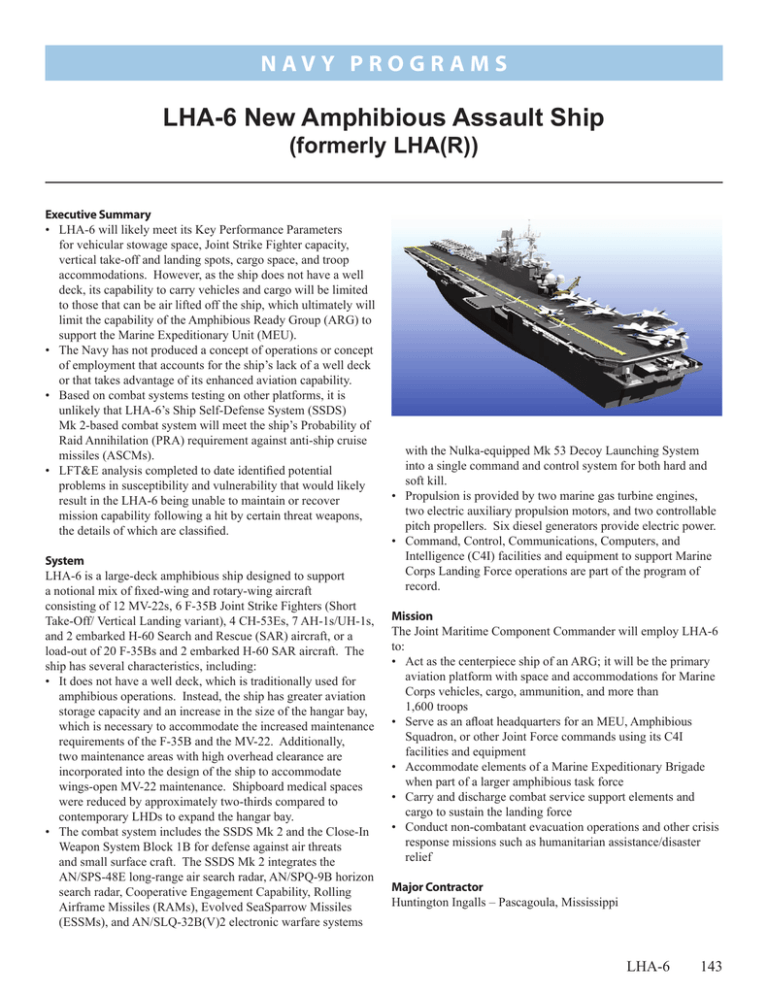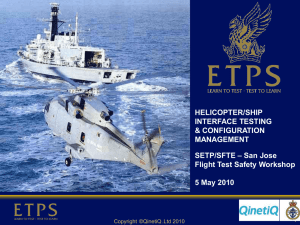LHA-6 New Amphibious Assault Ship (formerly LHA(R))
advertisement

N a v y P ROGRAMS LHA-6 New Amphibious Assault Ship (formerly LHA(R)) Executive Summary • LHA-6 will likely meet its Key Performance Parameters for vehicular stowage space, Joint Strike Fighter capacity, vertical take-off and landing spots, cargo space, and troop accommodations. However, as the ship does not have a well deck, its capability to carry vehicles and cargo will be limited to those that can be air lifted off the ship, which ultimately will limit the capability of the Amphibious Ready Group (ARG) to support the Marine Expeditionary Unit (MEU). • The Navy has not produced a concept of operations or concept of employment that accounts for the ship’s lack of a well deck or that takes advantage of its enhanced aviation capability. • Based on combat systems testing on other platforms, it is unlikely that LHA-6’s Ship Self-Defense System (SSDS) Mk 2-based combat system will meet the ship’s Probability of Raid Annihilation (PRA) requirement against anti-ship cruise missiles (ASCMs). • LFT&E analysis completed to date identified potential problems in susceptibility and vulnerability that would likely result in the LHA-6 being unable to maintain or recover mission capability following a hit by certain threat weapons, the details of which are classified. System LHA-6 is a large-deck amphibious ship designed to support a notional mix of fixed-wing and rotary-wing aircraft consisting of 12 MV-22s, 6 F-35B Joint Strike Fighters (Short Take‑Off/ Vertical Landing variant), 4 CH-53Es, 7 AH-1s/UH-1s, and 2 embarked H-60 Search and Rescue (SAR) aircraft, or a load‑out of 20 F-35Bs and 2 embarked H-60 SAR aircraft. The ship has several characteristics, including: • It does not have a well deck, which is traditionally used for amphibious operations. Instead, the ship has greater aviation storage capacity and an increase in the size of the hangar bay, which is necessary to accommodate the increased maintenance requirements of the F-35B and the MV-22. Additionally, two maintenance areas with high overhead clearance are incorporated into the design of the ship to accommodate wings-open MV-22 maintenance. Shipboard medical spaces were reduced by approximately two-thirds compared to contemporary LHDs to expand the hangar bay. • The combat system includes the SSDS Mk 2 and the Close-In Weapon System Block 1B for defense against air threats and small surface craft. The SSDS Mk 2 integrates the AN/SPS‑48E long-range air search radar, AN/SPQ-9B horizon search radar, Cooperative Engagement Capability, Rolling Airframe Missiles (RAMs), Evolved SeaSparrow Missiles (ESSMs), and AN/SLQ-32B(V)2 electronic warfare systems with the Nulka-equipped Mk 53 Decoy Launching System into a single command and control system for both hard and soft kill. • Propulsion is provided by two marine gas turbine engines, two electric auxiliary propulsion motors, and two controllable pitch propellers. Six diesel generators provide electric power. • Command, Control, Communications, Computers, and Intelligence (C4I) facilities and equipment to support Marine Corps Landing Force operations are part of the program of record. Mission The Joint Maritime Component Commander will employ LHA-6 to: • Act as the centerpiece ship of an ARG; it will be the primary aviation platform with space and accommodations for Marine Corps vehicles, cargo, ammunition, and more than 1,600 troops • Serve as an afloat headquarters for an MEU, Amphibious Squadron, or other Joint Force commands using its C4I facilities and equipment • Accommodate elements of a Marine Expeditionary Brigade when part of a larger amphibious task force • Carry and discharge combat service support elements and cargo to sustain the landing force • Conduct non-combatant evacuation operations and other crisis response missions such as humanitarian assistance/disaster relief Major Contractor Huntington Ingalls – Pascagoula, Mississippi LHA-6 143 N a v y P ROGRAMS Activity • The Navy conducted an operational assessment from June to August 2008 in accordance with the DOT&E-approved test plan. Experienced fleet operators (Navy and Marine Corps) reviewed ship plans and specifications, data on fielded systems, and previous testing conducted on systems that will be installed on LHA-6. Since that time, no specific operational testing has occurred with the exception of enterprise testing on the Self-Defense Test Ship (SDTS). Further information on the SDTS can be found in the Ship Self Defense report. • The Navy has conducted a variety of LFT&E testing and analyses using surrogate ship platforms (including the ex‑Saipan (LHA-2) and scale models to develop an understanding of vulnerabilities of LHA-6 design against typical weapons effects. The Navy will prepare a survivability assessment report in FY12. • The Test and Evaluation Master Plan (TEMP) is under revision Assessment • LHA-6 will likely meet its Key Performance Parameters for vehicular stowage space, Joint Strike Fighter capacity, vertical take-off and landing spots, cargo space, and troop accommodations, but because the ship does not have a well deck, its capability to carry vehicles and cargo will be limited to those that can be air lifted off the ship. This ultimately will limit the capability of the ARG to support the MEU. • The Navy and Marine Corps have not produced a concept of operations or concept of employment that accounts for the ship’s lack of a well deck or that takes advantage of its enhanced aviation capability. • LHA-6 provides substantially reduced medical capabilities as compared to current LHA and LHD-class ships. • SSDS Mk 2-based combat systems testing revealed deficiencies and limitations that make it unlikely that LHA-6 will meet its PRA requirements. Specific deficiencies and limitations include the following: - ESSM has not demonstrated capability against the three classes of ASCM threats that justified its development. - RAM’s performance is degraded against certain threat profiles. - Due to long-standing and previously identified legacy sensor limitations, LHA-6 may be vulnerable to certain airborne threat flight profiles. - Nulka’s flight profile, during recent test events, deviated from expectations significantly enough to degrade its effectiveness against some threats. Additionally, the time required to deploy Nulka was longer than allowed by standard Navy tactics, which reduces its effectiveness. - Training deficiencies with SSDS Mk 2-based combat systems continue to degrade the system’s effectiveness. - Nulka and SLQ-32’s capability is substantially degraded against a certain type of modern ASCM threats. - To date, ESSM and RAM have only had limited amount of testing against Low Velocity Air Threats under operationally-realistic conditions. 144 LHA-6 • The ship’s Collective Protection System (CPS) is not designed to protect critical operational and medical spaces and provides less coverage then the CPS being retrofitted to the LHD-1 class. • Jet blast from the F-35Bs is expected to produce unsafe forces on flight deck personnel up to 75 feet from the short take-off line. • MV-22 operations produce heat levels that might damage the flight deck and overwhelm the environmental controls in the spaces immediately below the flight deck. • The vehicle ramp for moving equipment from the hangar deck to the flight deck is limited to 12,000 pounds and cannot handle the weight of armored High Mobility Multi-purpose Wheeled Vehicles (HMMWVs) • LFT&E analysis completed to date identified potential problems in susceptibility and vulnerability that would likely result in the LHA-6 being unable to maintain or recover mission capability following a hit by threat weapons. - Some fluid systems need additional isolation valves, sensors and remote operators to allow rapid identification and isolation of damage and reconfiguration for restoration of the mission capability they support. - Electrical power continuity following damage to critical C4I and self defense systems needs to be improved. - The hangar bay needs a divisional door to limit damage from fire and smoke. • Planned flight deck manning is insufficient to support the surge flight deck operations at the level required by the CDD. Recommendations • Status of Previous Recommendations. In response to the FY08 recommendations, the Navy conducted a study to re-affirm their decision to remove two Nulka launchers, and partially addressed the recommendation to add an AN/ SPA-48E radar to the SDTS, but still needs adequate resources to procure enough targets for IOT&E. The five remaining FY08 recommendations are still valid. Additionally, one FY05 recommendation remains regarding the need to conduct detailed analyses to understand cargo, vehicle, and passenger flow routes throughout the ship to support troop embarkation, debarkation, and backload. • FY11 Recommendations. The Navy should: 1. Conduct an end-to-end analysis to discover– ▪▪ How the ARG will compensate for the lost surface connector capability ▪▪ If the medical spaces will be adequate to support the MEU needs ▪▪ If an LHA-6-centered ARG can support the rapid buildup of forces ashore 2. Develop a concept of operations or concept of employment to describe LHA-6 employment. 3. Alter the vehicle ramp from the hangar bay to the flight deck to accommodate the up-armored HMMWV. N a v y P ROGRAMS 4. Ensure that systems engineering deficiencies related to SSDS Mk 2-based combat systems and other combat system deficiencies are corrected so that LHA-6 can satisfy its PRA requirement. 5. Back-fit the alterations to the LHD-1 CPS into LHA-6 and program them for LHA-7 to improve and expand the protected area. 6. Consider the use of solid state automatic bus transfer switches to improve the survivability of electrical power to vital C4I and self-defense systems to improve survivability. 7. Consider hangar bay divisional doors for LHA-7 to improve the ability to contain a fire and limit the spread of smoke and damage to improve survivability. 8. Provide improved isolation valves and pressure transducers to enable the crew to isolate damage and restore vital fluid systems to improve survivability. 9. Study flight deck manning needs to support surge operations. Mitigation plans should be demonstrated during IOT&E. 10.Determine mitigations for safe operations of the F-35B and MV-22 from the flight deck. 11.The survivability improvement recommendations resulting from the analysis of the LHA-6 design should be evaluated for incorporation into the LHA-7 design. LHA-6 145 N a v y P ROGRAMS 146



